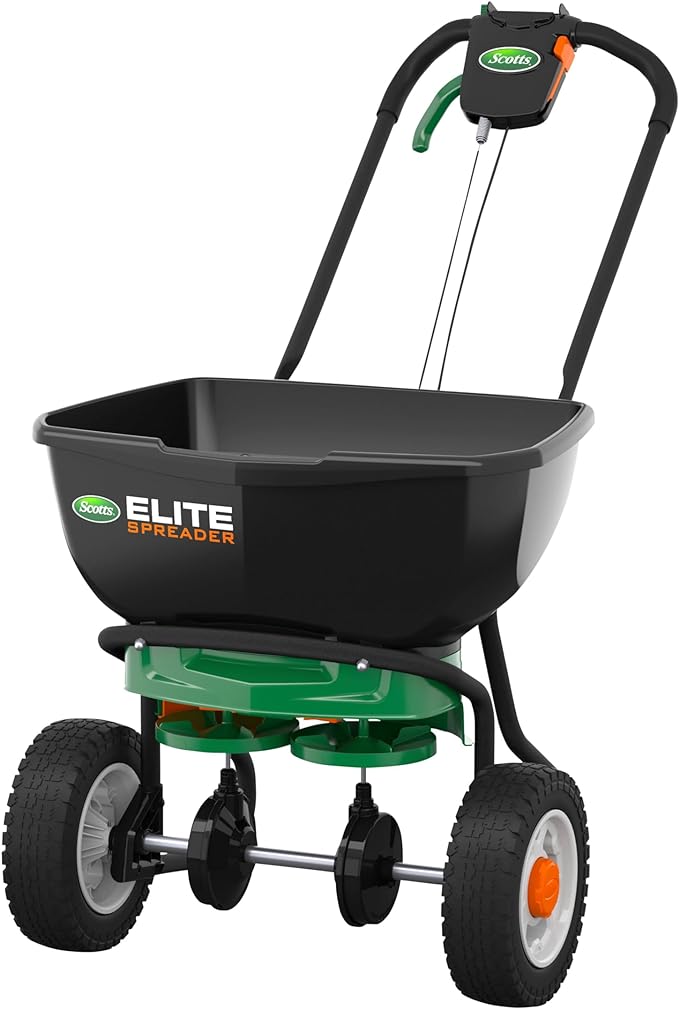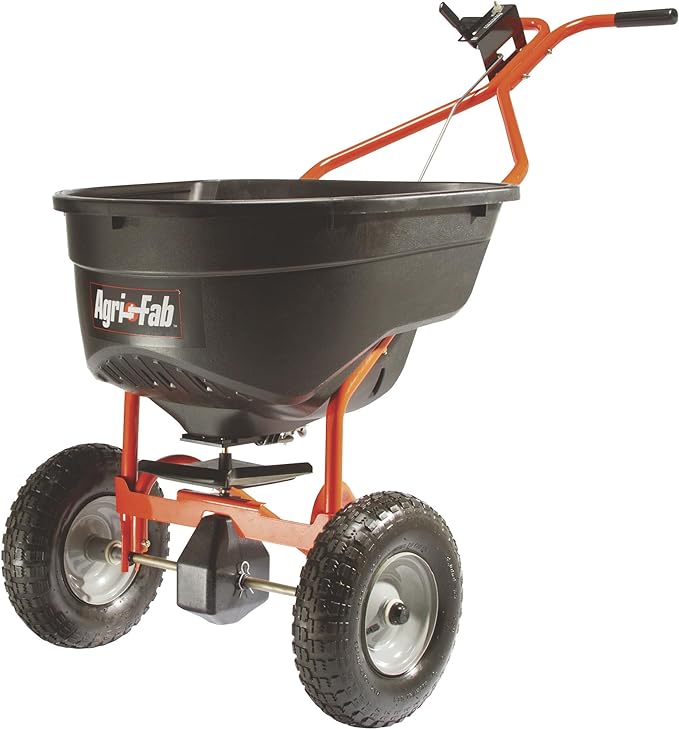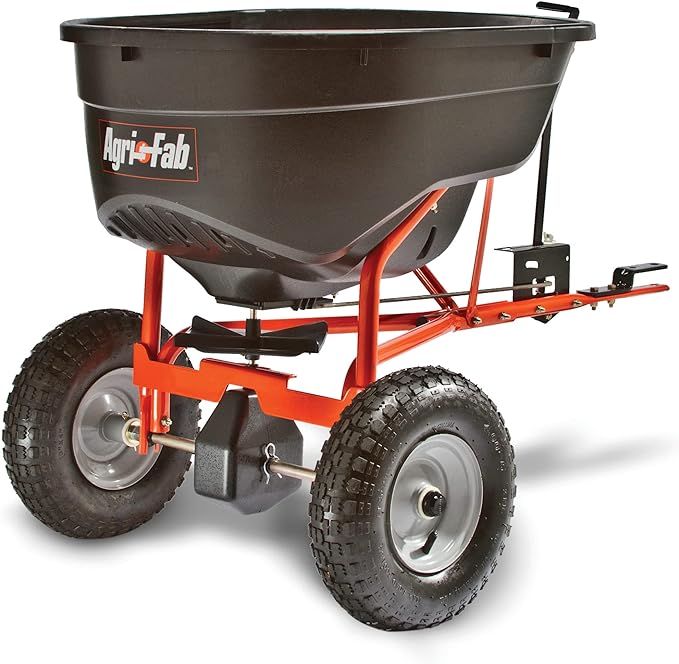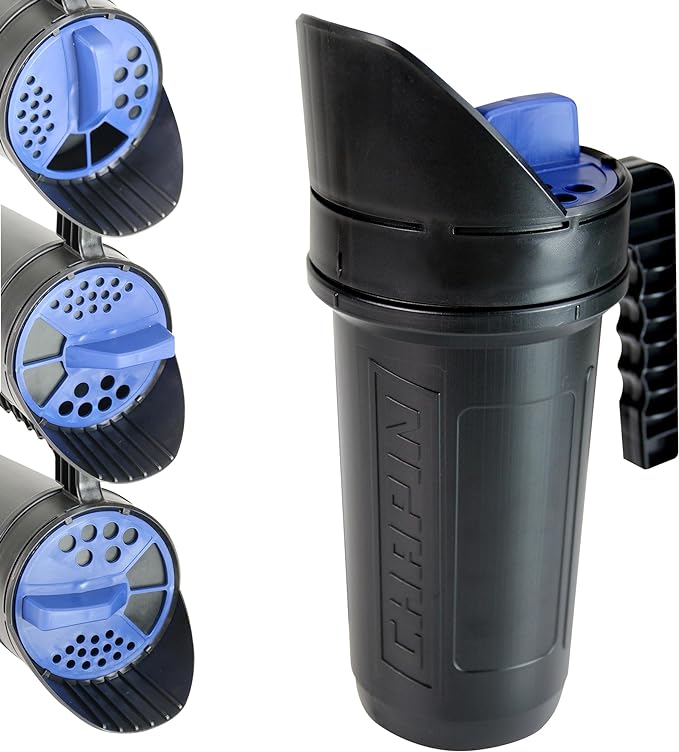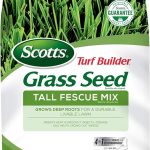Did you know that 70% of homeowners invest in lawn care, with fertilizer application being a vital step? You’re likely part of this statistic, and choosing the right fertilizer spreader can make all the difference. With so many options available, it’s overwhelming to navigate the market. You’re probably wondering which spreader will give you the best results for your lawn. From tow-behind models to handheld options, each type has its strengths and weaknesses. But don’t worry, our expert guidance is here to help. Let’s explore the top six fertilizer spreaders that’ll help you achieve a lush, green lawn, and discover which one is right for you.
Contents [show]
Scotts Elite Spreader for Grass Seed
If you’re a homeowner looking to efficiently fertilize your lawn year-round, the Scotts Elite Spreader for Grass Seed is an excellent choice, offering a 20% faster application rate compared to standard 5 ft. spread patterns.
This advanced spreader is engineered to provide accurate and efficient application, making it ideal for fertilizing your lawn throughout the year.
With a capacity to hold up to 20,000 sq. ft. of product, you can cover a large area with ease.
The dual rotors guarantee exceptional accuracy, and the ergonomic handle comes equipped with a smartphone holder for added convenience.
Plus, with Scotts EdgeGuard technology, you can rest assured that your lawn will receive the precise amount of fertilizer it needs.
Best For: Homeowners who want to efficiently fertilize their lawns year-round with accurate and efficient application.
Pros:
- Offers a 20% faster application rate compared to standard 5 ft. spread patterns
- Has a large capacity to hold up to 20,000 sq. ft. of product, covering a large area with ease
- Features dual rotors for exceptional accuracy and an ergonomic handle with a smartphone holder for added convenience
Cons:
- No specific cons mentioned in the product description or customer reviews
- No specific cons mentioned in the product description or customer reviews
- No specific cons mentioned in the product description or customer reviews
Agri-Fab 45-0462 Push Broadcast Spreader,Orange & Black,130-lb Capacity
With its 130-lb capacity and 1/2 acre coverage, the Agri-Fab 45-0462 Push Broadcast Spreader is the best choice for homeowners with larger lawns who need a reliable and efficient fertilizer spreader.
You’ll appreciate the spreader’s balanced and smooth operation, making it easy to cover a lot of ground quickly.
The spreader rate is also easy to adjust with the wing nut and calibration scale, ensuring you get an even application of fertilizer.
Plus, the large 13 x 4 pneumatic tires make it easy to maneuver around your lawn.
When you’re done, cleaning up is a breeze with a garden hose and blower.
Overall, the Agri-Fab 45-0462 is a solid choice for those looking for a mid-grade spreader that can handle heavy use.
Best For: Homeowners with larger lawns who need a reliable and efficient fertilizer spreader.
Pros:
- Well-built and sturdy spreader suitable for heavy use
- Easy to use and clean, with a large hopper capacity
- Distributes material more evenly and carries a larger load
Cons:
- Assembly can be time-consuming and requires mechanical skills
- No deflectors, which can cause product to fly back at the user
- Parts may not be well-protected in shipping, leading to potential rust
Brinly AS2-40BH Tow Behind Aerator Spreader
When you need a 2-in-1 solution that can both aerate and spread seed, fertilizer, or lime simultaneously, the Brinly AS2-40BH Tow Behind Aerator Spreader is the best choice for you, offering a thorough lawn care experience.
With its 2-in-1 design, you can tackle two tasks at once, saving you time and effort.
The spreader features 3-D tines made of galvanized steel for strength and rust resistance, and an all-steel hopper with a 100-pound capacity and calibrated flow control.
You’ll also appreciate the 132 tine tips that allow for deep soil penetration and access for air, water, and nutrients.
Plus, the 10 pneumatic transport wheels make it easy to move around your lawn.
Best For: Lawn owners who need to aerate and spread seed, fertilizer, or lime simultaneously, and are looking for a efficient and effective solution for their lawn care needs.
Pros:
- 2-in-1 design allows for simultaneous aeration and spreading of seed, fertilizer, or lime, saving time and effort
- 3-D tines made of galvanized steel provide strength and rust resistance, and 132 tine tips allow for deep soil penetration and access for air, water, and nutrients
- Easy to transport with 10 pneumatic wheels, making it convenient to move around the lawn
Cons:
- May not be suitable for hard, dry soil, and may require watering to soften the soil before use
- Some users have experienced issues with the chain-driven auger and wheel design
- Assembly can be difficult, and poor design of certain components has been reported by some users
Scotts Wizz Handheld Spreader
For homeowners seeking a reliable and accurate spreader for year-round use, the Scotts Wizz Handheld Spreader is an excellent choice, capable of covering up to 2,500 square feet with unbeatable precision.
This battery-powered spreader boasts a 5-foot broadcast and Edgeguard technology, ensuring you get the job done efficiently.
With 23 spreader settings, you’ll have precise control over the distribution of your fertilizer, grass seed, salt, or ice melt.
The acrylic-made spreader is lightweight, weighing just 2.1 pounds, and has a compact design that makes it easy to store.
You’ll need 4 AA batteries to get started, and with a 4.3-star rating from over 13,000 customers, you can trust that this spreader will deliver on its promises.
Best For: Homeowners who need a reliable and accurate spreader for year-round use, covering small to medium-sized areas.
Pros:
- Easy to use and accurate in spreading fertilizer, grass seed, salt, or ice melt.
- Battery-powered with 5-foot broadcast and Edgeguard technology for efficient spreading.
- Lightweight and compact design makes it easy to store and transport.
Cons:
- Some users have reported design flaws and corrosion issues.
- Poor packaging has been a problem for some customers.
- Some users have reported issues with the product’s durability.
Agri-Fab 45-0463 130-Pound Tow Behind Broadcast Spreader
If you’re looking for a fertilizer spreader that can cover a large area quickly and efficiently, the Agri-Fab 45-0463 130-Pound Tow Behind Broadcast Spreader is an excellent choice, thanks to its impressive 10-12 foot spread width and 130-pound capacity.
This tow-behind broadcast spreader is designed to help you tackle big jobs with ease, covering up to 1/2 acre (25,000 sq. ft.) with a single fill.
You’ll appreciate its easy-to-use universal hitch and direct rod control, making operation a breeze.
Plus, with 13 x 4 pneumatic tires, you can count on a smooth ride across your lawn.
With a 3-year limited warranty and a durable alloy steel, polypropylene, and rubber construction, you can trust this spreader to get the job done season after season.
Best For: Large lawn owners who need to cover a significant area quickly and efficiently.
Pros:
- Covers a large area quickly and efficiently with a 10-12 foot spread width and 130-pound capacity
- Easy to use with a universal hitch and direct rod control
- Durable construction with a 3-year limited warranty
Cons:
- Assembly required, which can take around 2 hours and may require mechanical skills
- Open and close lever may not be reachable from the mower seat
- Requires regular maintenance, such as rinsing after every use, to extend its lifespan
Chapin 8740A Poly Hand Shaker Spreader
The Chapin 8740A Poly Hand Shaker Spreader is an excellent choice for those who need a versatile and convenient spreader for year-round use, as it can handle everything from salt and ice melt to seed and fertilizers.
You’ll appreciate its 64-ounce high-capacity poly bottle with a wide opening and easy screw top, making it easy to fill and refill.
The three openings in the lid accommodate different particulates, and the large grip handle fits comfortably in your hand, even with gloves on.
Weighing just 11.2 ounces, this spreader is lightweight and portable, making it easy to store in a closet, on a shelf, or even in your car.
With its simple design and ease of use, you’ll be spreading like a pro in no time!
Best For: Landscapers, homeowners, and gardeners who need a versatile and convenient spreader for year-round use, handling salt, ice melt, seed, and fertilizers.
Pros:
- Easy to operate with one hand, even with gloves on
- 64-ounce high-capacity poly bottle with a wide opening and easy screw top
- Portable and lightweight, weighing only 11.2 ounces
Cons:
- Some users have reported clogging issues
- Limited capacity may require frequent refills
- Not suitable for large areas or commercial use
Factors to Consider When Choosing Fertilizer Spreaders
When selecting the right fertilizer spreader for your needs, you’ll want to think carefully about several key factors to guarantee you get the best results.
You’ll need to ponder the type of spreader that’s right for your lawn or garden, as well as the size of the area you need to cover.
Additionally, you’ll want to weigh the capacity of the spreader, how easy it’s to assemble and maintain, and other important details that can make a big difference in your fertilizer application.
Spreader Type Matters
Choosing the right fertilizer spreader type is vital, as it directly affects the efficiency and effectiveness of your lawn care routine.
You’ll need to ponder the size of your lawn, the type of fertilizer you’re using, and the level of precision you need.
Broadcast spreaders are great for large areas, covering up to 25,000 square feet, but may not be precise and can lead to over-fertilization.
If you have a smaller lawn, a drop spreader might be a better fit, as they’re more accurate and ideal for small to medium-sized areas. However, you may need to make multiple passes to cover the entire lawn.
If you have a tiny lawn or just need to fertilize a small section, a handheld spreader is portable and convenient. Just be aware that it may not be suitable for large lawns and can be time-consuming.
Tow-behind spreaders are designed for large areas and can be attached to a lawn tractor or ATV, but require more effort to assemble and maintain.
Coverage Area Needs
Determine your lawn’s specific coverage needs before selecting a fertilizer spreader, as this key factor will substantially impact the efficiency and effectiveness of your lawn care routine.
You’ll want to contemplate the size of the area that needs to be covered, as larger areas may require a tow-behind or push spreader with a higher capacity. For example, the Agri-Fab 45-0462 can cover up to 25,000 square feet. On the other hand, smaller areas may only need a handheld spreader like the Scotts Wizz, which can cover up to 2,500 square feet.
The type of fertilizer or material being spread also affects the coverage area, as some spreaders are designed for specific materials. Additionally, the spread pattern and width of the spreader impact the coverage area.
For instance, the Brinly AS2-40BH has a spread width of 10-12 feet. This is crucial for choosing a spreader that can efficiently cover your target area, thereby guaranteeing even distribution of the fertilizer or material, regardless of the size of the area.
Material Capacity Counts
You’ll need to determine the material capacity of a fertilizer spreader to guarantee it can hold enough product for your lawn, as running out mid-application can lead to uneven distribution and wasted time.
Consider the size of your lawn and the coverage area you need to fertilize. A small to medium-sized lawn might require a spreader with a capacity of 5,000 to 10,000 square feet, while larger lawns may need a spreader with a capacity of 20,000 square feet or more.
When choosing a fertilizer spreader, think about the type of fertilizer you’ll be using. Granular fertilizers typically require a larger capacity than liquid or organic fertilizers.
You should also consider the flow rate, which is the amount of fertilizer released per square foot. A higher flow rate means you’ll need a larger capacity spreader to facilitate even distribution.
Lastly, consider the frequency of use and the maintenance requirements of the spreader. If you plan to fertilize your lawn regularly, you may want a spreader with a larger capacity to reduce the number of refills needed.
Ease of Assembly
When selecting a fertilizer spreader, consider how much time and effort you’re willing to devote to assembly, as some models require a significant amount of time and mechanical skill to get up and running.
For instance, the Agri-Fab 45-0462 Push Broadcast Spreader and Agri-Fab 45-0463 130-Pound Tow Behind Broadcast Spreader require around an hour to assemble and may need some mechanical know-how.
You might need to spend up to two hours assembling the latter, so be prepared to be patient. Having a spacious workspace and basic DIY skills can make the process smoother.
It’s also essential to carefully read the instructions and take inventory of the parts before starting the assembly process.
On the other hand, some spreaders, like the Scotts Wizz Handheld Spreader, don’t require assembly, making them a convenient option for those who want to start using their spreader quickly.
Maintenance Requirements
Regular maintenance is essential to extending the lifespan of your fertilizer spreader, and you should consider the maintenance requirements of a model before making a purchase.
You’ll want to think about how often you’ll need to clean and lubricate the spreader, as well as how easily you can access and replace worn-out parts. Some fertilizer spreaders may require more frequent cleaning to prevent clogs, while others might’ve specialized parts that need to be replaced periodically.
When evaluating maintenance requirements, consider the type of fertilizer you’ll be using and how it might affect the spreader’s performance over time.
Look for models with easy-to-remove hoppers and trays that can be quickly cleaned with a hose. Additionally, consider the warranty and customer support offered by the manufacturer.
A good warranty can provide peace of mind and protect your investment in case you encounter any issues with your fertilizer spreader. By considering maintenance requirements upfront, you can confirm you’re getting a model that will serve you well for years to come.
Frequently Asked Questions
Can I Use a Fertilizer Spreader for Ice Melting Products?
You’re wondering if you can use a fertilizer spreader for ice melting products, and the answer is yes, you can! Many spreaders are designed for versatility, allowing you to spread ice melters like rock salt or calcium chloride.
Do Fertilizer Spreaders Work Well on Uneven or Hilly Lawns?
You’ll find that fertilizer spreaders can be tricky on uneven or hilly lawns, as they can leave uneven distributions or even clog on slopes. You’ll need to adjust your spreader’s settings and pace to compensate for the terrain.
How Often Should I Calibrate My Fertilizer Spreader?
You should calibrate your fertilizer spreader every 1-2 months or after each use to guarantee accurate application, as worn or clogged parts can affect distribution, leading to uneven fertilization and potential lawn damage.
Are Fertilizer Spreaders Suitable for Small Lawn Areas?
You’ll be surprised to know that 75% of homeowners have lawns smaller than 1/4 acre! For your small lawn area, yes, fertilizer spreaders can be suitable, but consider handheld or walk-behind models for more precision and control.
Can I Use a Fertilizer Spreader for Applying Pesticides?
You’re wondering if you can use a fertilizer spreader for applying pesticides. Generally, it’s not recommended, as pesticides have different dispersal patterns and droplet sizes than fertilizers, requiring specialized equipment for effective and safe application.
Conclusion
You’ve got the power to transform your lawn into a lush oasis!
With the right fertilizer spreader, you’ll be spreading success, not seeds of doubt.
Remember, the perfect spreader is like a trusted sidekick, helping you conquer lawn care with ease.
Choose wisely, and your grass will be the envy of the neighborhood.
